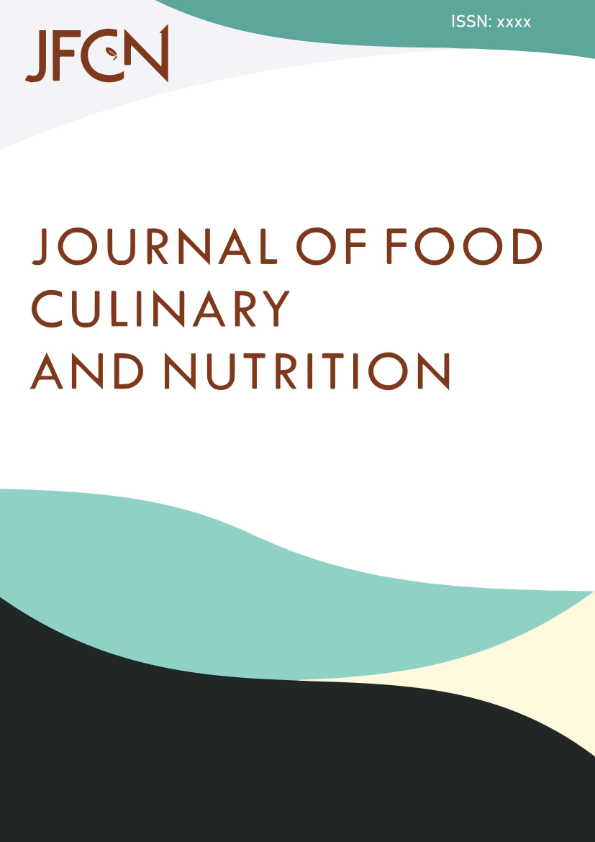Antioxidant Profile of Velvet Bean and Jack Bean and The Effect of Processing Towards Its Value – A Review
Abstract
Keywords
Full Text:
PDFReferences
Deli, M., Nguimbou, R. M., Djantou, E. B., Tatsadjieu Ngoune, L., & Njintang Yanou, N. (2020). Bioactive compounds of velvet bean (Mucuna pruriens L.) seeds. Bioactive Compounds in Underutilized Vegetables and Legumes, 1-19.
Dimitry, M. Y., Therèse, B. A. M., Edith, D. M. J., Armand, A. B., & Nicolas, N. Y. (2022). Hypolipidemic and antioxidant effects of vegetal milk produced with Mucuna pruriens L. seed in rats fed a high-fat diet. Heliyon, 8(11).
Diniyah, N., Alam, M. B., & Lee, S. H. (2020). Antioxidant potential of non-oil seed legumes of Indonesian’s ethnobotanical extracts. Arabian Journal of Chemistry, 13(5), 5208-5217.
Diniyah, N., Bulgis, U. M., & Marchianti, A. C. N. (2023). Antioxidant activity and phytochemical compositions of Mucuna pruriens L. in different conditions of time and temperature extraction. In IOP Conference Series: Earth and Environmental Science (Vol. 1177, No. 1, p. 012042). IOP Publishing.
Dulce-María, D. A., Adrián, C. R., Cuauhtémoc, R. M., Ada-Keila, M. N., Jorge, M. C., Erika, A. S., & Edith-Oliva, C. R. (2021). Isoflavones from black chickpea (Cicer arietinum L) sprouts with antioxidant and antiproliferative activity. Saudi journal of biological sciences, 28(1), 1141-1146.
Ezegbe, C. C., Nwosu, J. N., Owuamanam, C. I., Victor-Aduloju, T. A., & Nkhata, S. G. (2023). Proximate composition and anti-nutritional factors in Mucuna pruriens (velvet bean) seed flour as affected by several processing methods. Heliyon, 9(8).
Hanum, I. Faridah and L.J.G Van der Maesen, “PROSEA : Plant Resources of South-East Asia 11, Auxiliary Plants”, Prosea Foundation, Bogor, 1997.
Hong, P. Y., Huang, Y. H., Lim, G. C. W., Chen, Y. P., Hsiao, C. J., Chen, L. H., ... & Hsieh, L. S. (2021). Production of trans-cinnamic acid by immobilization of the Bambusa oldhamii BoPAL1 and BoPAL2 phenylalanine ammonia-lyases on electrospun nanofibers. International Journal of Molecular Sciences, 22(20), 11184.
Iamsaard, S., Arun, S., Burawat, J., Yannasithinon, S., Tongpan, S., Bunsueb, S., Lapyuneyong, N., Choowong-in, P., Tangsrisakda, N., Chaimontri, C., & Sukhorum, W. (2020). Evaluation of antioxidant capacity and reproductive toxicity of aqueous extract of Thai Mucuna pruriens seeds. Journal of Integrative Medicine, 18(3), 265-273.
Ishmayana, S., Malini, D. M., & Soedjanaatmadja, U. M. (2023). Nutritional content and the activities of l-Dopa (L-3, 4-dihydoxyphenyalanine) from Mucuna pruriens L. DC seeds of Central Java accession. Arabian Journal of Chemistry, 16(1), 104390.
Jadhav, S. N., Nayyar, S., Hundal, J. S., & Singh, J. (2022). In-vitro evaluation of Mucuna pruriens seeds by nutritional and phytochemical analysis, assessment of antioxidant property and estimation of L-DOPA content by RP-HPLC. Pharma Innov., 11(1), 289-294.
Jimoh, M. A., Idris, O. A., & Jimoh, M. O. (2020). Cytotoxicity, phytochemical, antiparasitic screening, and antioxidant activities of Mucuna pruriens (Fabaceae). Plants, 9(9), 1249.
Kumbhare, S. D., Ukey, S. S., & Gogle, D. P. (2023). Antioxidant activity of Flemingia praecox and Mucuna pruriens and their implications for male fertility improvement. Scientific Reports, 13(1), 19360.
Liang, N., & Kitts, D. D. (2014). Antioxidant property of coffee components: assessment of methods that define mechanisms of action. Molecules, 19(11), 19180-19208.
Liu, W., Dun, M., Liu, X., Zhang, G., & Ling, J. (2022). Effects on total phenolic and flavonoid content, antioxidant properties, and angiotensin I-converting enzyme inhibitory activity of beans by solid-state fermentation with Cordyceps militaris. International Journal of Food Properties, 25(1), 477-491.
Oladunni, O. M., Olayinka, O. J., & Olalekan, O. (2024). Implications of dehusking and aqueous soaking on anti-nutrients, phytochemical screening and antioxidants properties of jack beans (Canavalia ensiformis L. DC). Journal of Research in Chemistry, 5(1): 135 – 142
Puspitojati, E., Muhammad Nur Cahyanto, Yustinus Marsono and Retno Indrati. (2019). Production of Angiotensin-I-Converting Enzyme (ACE) Inhibitory Peptides during the Fermentation of Jack Bean (Canavalia ensiformis) Tempe. Pakistan Journal of Nutrition, 18(5): 464-470.
Rahayu, N. A., Cahyanto, M. N., & Indrati, R. (2019). Pola perubahan protein koro benguk (Mucuna pruriens) selama fermentasi tempe menggunakan inokulum Raprima. Agritech, 39(2), 128-135.
Ramli, N. A. M., Chen, Y. H., Zin, Z. M., Abdullah, M. A. A., Rusli, N. D., & Zainol, M. K. (2021). Effect of soaking time and fermentation on the nutrient and antinutrients composition of Canavalia ensiformis (Kacang Koro). In IOP Conference Series: Earth and Environmental Science (Vol. 756, No. 1, p. 012033). IOP Publishing.
Shelke, D. B., Tayade, S., Gawande, P., & Sonawane, H. B. (2022). GC-MS analysis and antioxidant potential of wild underutilized medicinally important legume, velvet bean (Mucuna pruriens L. DC.). Notulae Scientia Biologicae, 14(1), 11098-11098.
Smartt, J., Nwokolo, E. “Food and Feed from Legumes and Oilseeds”. Springer US, Swiss, 2012.
Sowdhanya, D., Singh, J., Rasane, P., Kaur, S., Kaur, J., Ercisli, S., & Verma, H. (2023). Nutritional significance of velvet bean (Mucuna pruriens) and opportunities for its processing into value-added products. Journal of Agriculture and Food Research, 100921.
Sruthi D, Jayabaskaran C. (2024). Performance of Different Solvents and Extraction Methods on Therapeutic Potential of Mucuna pruriens (L.) DC. and Chemical Profiling of Screened Extract with Chromatography-Mass Spectrometry Approach. Current Research in Complementary & Alternative Medicine, 8: 237.
Sutedja, A. M., Yanase, E., Batubara, I., Fardiaz, D., & Lioe, H. N. (2020). Identification and characterization of α-glucosidase inhibition flavonol glycosides from jack bean (Canavalia ensiformis (L.) DC. Molecules, 25(11), 2481.
Sutedja, A. M., Ito, A., Yanase, E., Batubara, I., Fardiaz, D., & Lioe, H. N. (2021). Influence of jack bean (Canavalia ensiformis (L) DC) milk processing on bioactive compounds and its antioxidant activity. Food Science and Technology, 42, e11521.
Theansungnoen, T., Nitthikan, N., Wilai, M., Chaiwut, P., Kiattisin, K., & Intharuksa, A. (2022). Phytochemical analysis and antioxidant, antimicrobial, and antiaging activities of ethanolic seed extracts of four Mucuna species. Cosmetics, 9(1), 14.
USDA. Jack Bean (Canavalia ensiformis) Plant Guide [Internet]. United States Department of Agriculture. 2013 [cited 7 April 2024]. Available from: https://plants.usda.gov/DocumentLibrary/plantguide/pdf/pg_caen4.pdf.
DOI: https://doi.org/10.24167/jfcn.v1i2.12751
DOI (PDF): https://doi.org/10.24167/jfcn.v1i2.12751.g3172
Refbacks
- There are currently no refbacks.
Copyright (c) 2025 Journal of Food, Culinary, and Nutrition
Online ISSN : 3063-4121 JFCN Stats








